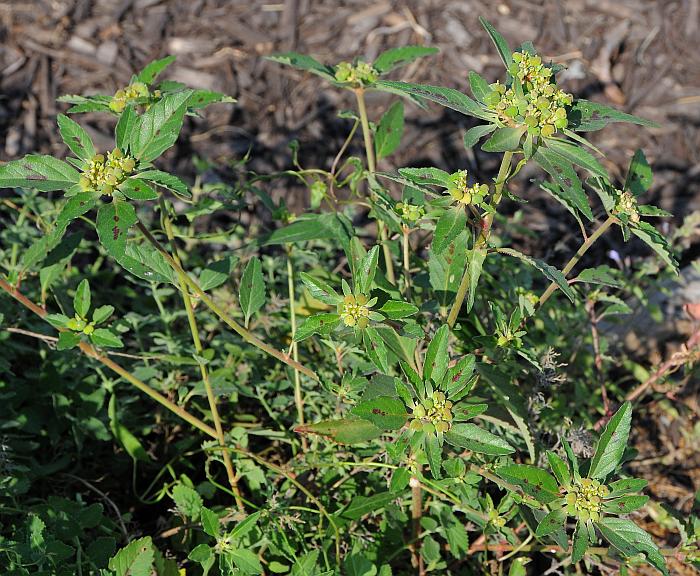Euphorbia davidii Subils
David's Spurge

Native
CC = 1
CW = 5
MOC = 34
© SRTurner
Euphorbia davidii SubilsDavid's Spurge | |
 |
Native CC = 1 CW = 5 MOC = 34 |
© SRTurner |
|
Family - Euphorbiaceae Habit - Taprooted annual forb with milky sap. Stem - Ascending to erect, to 70 cm, unbranched to several-branched, the branches not flattened toward the tip, usually green to yellowish green, occasionally reddish-to purplish-tinged, densely pubescent with minute, downward-angled hairs, also with sparse to moderate longer, multicellular hairs.
Leaves - Mostly opposite, simple, petiolate. Stipules absent or a pair of minute, light brown, convex, sessile glands. Leaf blades 10-100 mm long, highly variable in shape, linear to elliptic or sometimes lanceolate or ovate, not lobed, more or less symmetrically angled or tapered at the base, angled to tapered to a usually bluntly pointed tip, the margins irregularly and often relatively coarsely toothed or scalloped, the upper surface sparsely to moderately roughened with short, stiff, conical hairs having minutely pustular bases, green to dull grayish green and sometimes reddish-to purplish-tinged toward the margins or base, the undersurface moderately pubescent with relatively stout hairs, these often with a minute, persistent pustular base, and paler green than the upper surface.
Inflorescences - Terminal, small, umbellate panicles with a whorl of leaves at the base, frequently reduced to 1-3 small clusters of cyathia, glabrous.
Flowers - Involucre 2.5-3.0 mm long, glabrous, the rim irregularly lobed and fringed, the marginal glands 1 or less commonly 2, 0.7-1.2 mm long, appearing strongly concave and more or less 2-lipped, yellowish green to yellowish brown, lacking a petaloid appendage. Staminate flowers 25-40 per cyathium. Ovaries glabrous or with sparse, appressed hairs, the styles 1.0-1.5 mm long, each divided 1/2-3/4 of the way from the tip into 2 slightly slender or club-shaped lobes.
Fruits - Capsules 3-5 mm long (somewhat broader), 3-lobed, usually glabrous at maturity. Seeds 2.5-3.0 mm long, ovate to triangular-ovate in outline, bluntly angular in cross-section, more or less flattened at the base, the surface appearing relatively coarsely wrinkled or with poorly differentiated low, broad warts (appearing lumpy or irregularly swollen), these sometimes denser toward the angles, mostly dark brown or nearly black, often appearing somewhat mottled, usually with a small but well-developed, pale caruncle.
High resolution images are available on Tropicos. Flowering - July - October. Habitat - Streambanks, bottomland forests, prairies, sand prairies, ditches, railroads, roadsides, open disturbed areas. Origin - Native to the U.S., considered introduced in Missouri. Lookalikes - E. dentata. Other info. - This inconspicuous species has an unusual distribution, most commonly found in counties bordering the Missouri River, more scattered or rare in other portions of the state. Its main range is within parts of the Plains and the Southwest, though scattered populations are found in many other areas throughout the continental U.S. The plant is indistinguishable from the more common E. dentata at a casual glance. Differentiation can be accomplished in two ways. First, the leaves of E. davidii have stouter hairs with pustular bases. This can be detected by a slightly rougher feel to the leaf underside, but the difference is subtle and requires practice and experience. Second, the seeds of E. davidii are more angled and irregular than those of E. dentata, which are minutely pebbled but otherwise uniformly ovoid in shape. Photographs taken in St. Louis, St. Louis County, MO, 7-23-2015, and at Riverfront Park, Washington, Franklin County, MO, 9-15-2018 (SRTurner). |